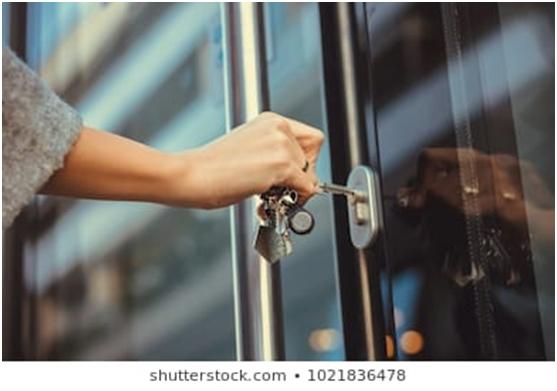If your Yale lock latch is broken and you are wondering if you can fix it yourself or whether you have to call in a locksmith, read on. This post will help you understand exactly what’s happening when you find your Yale lock latch broken and what needs to be done.
I live in an old house which was fitted with Yale locks many years ago. Recently, I have dealt with a few stuck lock latches. I’m wondering if it is time to change them or if minor repairs will do the trick.
Image courtesy of Pixabay
How a Lock Works
The front door in an average American home has a lockset(or lock) which comprises of two locks. These are alatch bolt and adeadbolt. The latch bolt (or latch) is an angle- edged bolt loaded with a spring. When the door is closed, the spring enables the angled edge of the bolt to press against the strike plate.This forces the latch to retract to allow the door close. When the door is fully closed, the spring releases the latch into a space in the strike plate. When you open the door using the door handle, the latch bolt retracts into the face plate, enabling the door to open.
A deadbolt is typically found just below, sometimes above, the latch bolt. Unlike the latch bolt, the deadbolt has a solid rectangular edge with no spring. It can only be moved back and forth (into the strike plate and back into the face plate) using a key. Deadbolt locks have a cylinder which contains a series of spring-loaded pins.The key pushes all the pins into a straight line which allows the cylinder to be turned and the door opened. When you use a wrong key, it either fails to enter the keyhole or fails to push all the pins into a straight-line position.
Causes of a Broken Lock Latch and Easy Solutions
It is not uncommon to come home and find your Yale lock latch broken. Whether it stops working with the door open or closed (yes it is a lot less complicated if it gets stuck with the door open) this is something that needs to be fixed immediately.
The ideal solution to any problem comes from a clear understanding of the cause. Let’s look at two common problems which could cause your door latch to fail and recommended solutions.
Misaligned Strike Plate
The best way to confirm that misalignment is your problem is if the latch extends and retracts as normal when the door is open but does not extend into its space on the strike plate as it should when the door is closed.Strike plates could lose alignment as a result of expansion of the wood on the door caused by moisture. Another possibility is that there is an issue with the foundation of the house, which causes the door frame on which the strike plate sits, to move up or down.
What is the solution? Unscrew the strike plate and move it up, down or to the side depending on the misalignment. Ensure the strike plate aligns with the latch. After that, widen the hole on the wood to allow the latch fit into it perfectly. Although this quick process is sure to solve the problem, it comes with the risk of weakening the screws because they are too close to the holes made the first time. When a thin splinter of wood is all that separates the screw and previously made hole, the entire strike plate is left very insecure.
Stuck Latch
The latch fails to extend or retract even when its control (door handle) moves in the manner of opening and closing as normal. This confirms that the problem is not on the door or the door handle but in the components which allow the latch to extend and retract. The most common cause is a build-up of material such as rust, although other materials could be stuck in-between components.
What is the solution? Disassemble the lock and wipe it down. Make a vinegar solution of about 5% acidity and let the lock components sit submerged in this solution for several hours. This helps clean out rust and other grime. Rust is caused by a natural oxidation process which cannot be prevented. It can only be slowed down. Rust also creates extremely high potential for re-rusting of the same piece of metal in the same spots. To prevent re-rusting in the near future, use car wax to cover and polish sections susceptible to rust. Let the polish dry and re-assemble the lock.
Conclusion
Some people strongly advice against tampering with your lock when problems arise. Theyinstead recommend calling in a professional locksmith to fix it. Whether you are a believer in solving these issues yourself or in letting the professionals do what they do best, now you have a clear understanding of the root cause of the problem. Next time you find your Yale lock latch broken, you will know exactly what needs to be done.
FAQ
My front door Yale lock has become harder and harder to open over the last few months. Sometimes I have to slam it to get the latch through when I close it. What can I do?
Put some graphite on the latch. Scribble a pencil hard over it. Avoid lubricating it with oil. This may help initially but will make things worse later because oil gathers dirt and dust.
Locked myself in the house. My Yale lock latch won’t move. What can I do?
Pass the key to someone who can try to unlock it from the outside. If it doesn’t work, try moving the snib on the inside part of the lock and ask them to try unlocking again.
The external part of my front door Yale lock is loose. The circular bit on the outside of the door, where the keyhole is, moves all the way round. It can also be pulled a few millimeters away from the door. How can I fix it?
Remove the lock and put it back on ensuring that the two long threaded rods which secure the cylinder are tightened.
How can I remove a broken key from my Yale lock?
Spray some penetrating oil into the keyhole to lubricate the bits. Use the tip of a pair of needle-nosed pliers to grip the broken key. Pull it out slowly to ensure you don’t lose the grip.


